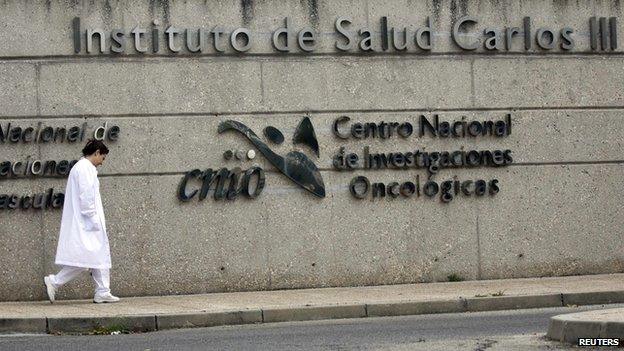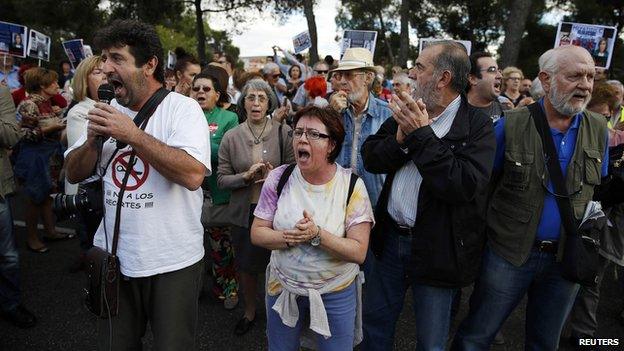Ebola: Spanish nurse Teresa Romero 'worsens'
- Published

A nurse in Spain became the first person to contract Ebola outside the current outbreak zone in West Africa
The health of a Spanish nurse who became the first person to contract Ebola outside of West Africa has worsened, a hospital official said on Thursday.
Teresa Romero's brother said her health had deteriorated and she was now being helped with her breathing in hospital.
Meanwhile, two doctors who treated her have been admitted for observation.
The admissions bring to six the total number of people under quarantine at the hospital in Madrid.
A spokesman for the Carlos III hospital said that so far neither of the two doctors recently admitted had shown Ebola symptoms.
Manuel Torres, Spanish nurse: "'We try our best, can we sometimes fail? Yes"
Ms Romero is the first person to have contracted the deadly virus outside West Africa.
She was part of a team of about 30 staff looking after two missionaries who later died from the virus after being repatriated from West Africa.
Ms Romero told a Spanish newspaper that she might have become infected when removing her protective suit after cleaning one of the missionaries' room.

Avoid direct contact with sick patients
Wear goggles to protect eyes
Clothing and clinical waste should be incinerated and any medical equipment that needs to be kept should be decontaminated
People who recover from Ebola should abstain from sex or use condoms for three months

On Wednesday she said that she was not feeling unwell, but now her condition has worsened although details remain unclear.
Her husband is among those being monitored.
The Ebola outbreak has already killed more than 3,000 people and infected more than 7,200, mostly in West Africa.
Spanish newspaper El Pais said that "a chain of human errors, external" had led to the first contagion of Ebola outside West Africa.
After cleaning the room of one of the missionaries following his death from the virus, Ms Romero took two days off from work and was instructed to monitor her temperature, the paper adds.

Protesters in Spain have been demonstrating against government spending cuts in the health care sector
Reports as to what happened next vary, but it is believed that several days after cleaning the room she called the hospital reporting feverish symptoms and a temperature of 37.6C.
Sources working at her primary health care centre - where she was referred - told Spanish media she had not explained that she had been in contact with Ebola-infected patients. As a result she was discharged with painkillers.
Missionary Miguel Pajares, 75, died on 12 August after contracting the virus in Liberia. Manuel Garcia Viejo, 69, died on 25 September after catching the disease in Sierra Leone.

Several aid organisations have criticised the global response to the outbreak, saying more needs to be done
Global developments
In other developments,
The US is introducing new security measures to screen passengers arriving from Ebola-affected countries in West Africa at five major US airports
In Texas, a county sheriff deputy was quarantined after visiting the home of the first person diagnosed with Ebola on US soil, who later died from the virus.
An Australian nurse recently returned from working with the Red Cross in Sierra Leone is undergoing testing in a hospital in Queensland. She is reported to have had an increased temperature but was "feeling well", the Red Cross said.
Thomas Duncan, 42, tested positive in Dallas, Texas, 10 days after arriving from his native Liberia.
He became ill a few days after arriving in the US. Even after going to hospital and telling medical staff he had been in Liberia, he was sent home with antibiotics.
Peter Piot, one of the scientists who discovered Ebola in 1976, has told the BBC more must be done to stop the spread of the virus, saying he never imagined an outbreak "could have got to this point".

-
Protective Ebola suit
× -
Surgical cap
×The cap forms part of a protective hood covering the head and neck. It offers medical workers an added layer of protection, ensuring that they cannot touch any part of their face whilst in the treatment centre.
-
Goggles
×Goggles, or eye visors, are used to provide cover to the eyes, protecting them from splashes. The goggles are sprayed with an anti-fogging solution before being worn. On October 21, the US Centers for Disease Control and Prevention (CDC) announced stringent new guidelines for healthcare personnel who may be dealing with Ebola patients. In the new guidelines, health workers are advised to use a single use disposable full face shield as goggles may not provide complete skin coverage.
-
Medical mask
×Covers the mouth to protect from sprays of blood or body fluids from patients. When wearing a respirator, the medical worker must tear this outer mask to allow the respirator through.
-
Respirator
×A respirator is worn to protect the wearer from a patient's coughs. According to guidelines from the medical charity Medecins Sans Frontieres (MSF), the respirator should be put on second, right after donning the overalls.
-
Medical Scrubs
×A surgical scrub suit, durable hospital clothing that absorbs liquid and is easily cleaned, is worn as a baselayer underneath the overalls. It is normally tucked into rubber boots to ensure no skin is exposed.
-
Overalls
×The overalls are placed on top of the scrubs. These suits are similar to hazardous material (hazmat) suits worn in toxic environments. The team member supervising the process should check that the equipment is not damaged.
-
Double gloves
×A minimum two sets of gloves are required, covering the suit cuff. When putting on the gloves, care must be taken to ensure that no skin is exposed and that they are worn in such a way that any fluid on the sleeve will run off the suit and glove. Medical workers must change gloves between patients, performing thorough hand hygiene before donning a new pair. Heavy duty gloves are used whenever workers need to handle infectious waste.
-
Apron
×A waterproof apron is placed on top of the overalls as a final layer of protective clothing.
-
Boots
×Ebola health workers typically wear rubber boots, with the scrubs tucked into the footwear. If boots are unavailable, workers must wear closed, puncture and fluid-resistant shoes.
